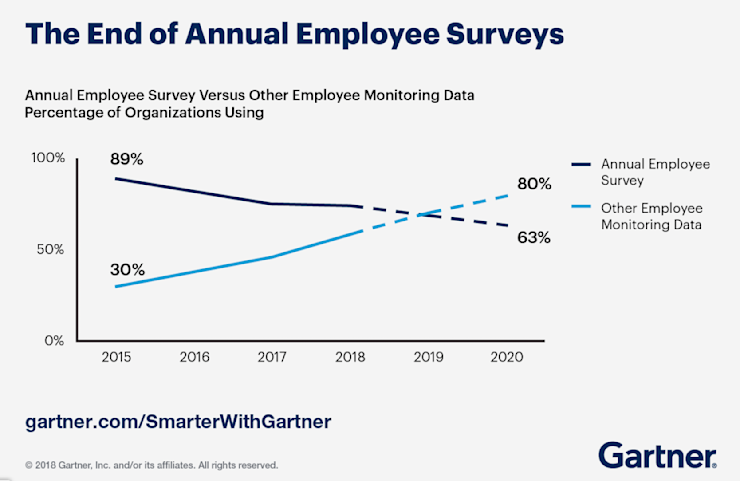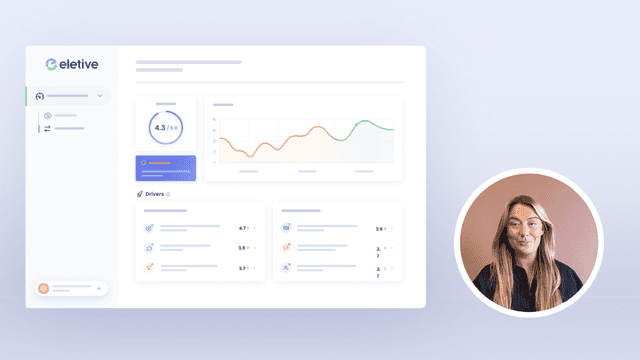What is an employee pulse survey, and why is an increasing number of companies opting for regular pulse surveys instead of annual employee engagement surveys?
We’re in the middle of a paradigm shift. The large and often overly formal annual surveys of the past are being replaced with modern tools.
Instead of using extensive yearly surveys, an increasing number of companies are opting for real-time pulse surveys to monitor the state of their organisation.
But is that a smart move?
In this comprehensive guide, we’ll delve into the world of pulse surveys, exploring their benefits and comparing them to traditional annual employee engagement surveys. So you know which one is right for you.
Pulse surveys are digital employee engagement surveys that are regularly sent out to the employees.
They enable HR and management to understand how employees experience their work environment, how they feel about their work, and where there is potential for improvement.
Unlike traditional annual employee surveys, pulse surveys are shorter in length and administered more frequently, typically on a monthly or quarterly basis. This allows HR managers to monitor employee sentiment continuously and make timely adjustments as needed.
Key features of pulse surveys
Brevity: Pulse surveys usually consist of just a few questions that can be answered quickly by employees.
Frequency: These surveys are conducted regularly (e.g., monthly or quarterly) to capture ongoing insights into employee engagement and performance.
Anonymity: To encourage honest responses, pulse surveys often allow participants to remain anonymous.
Focused Topics: Questions in pulse surveys tend to focus on specific areas such as leadership effectiveness, company culture, or job satisfaction.
The main goal of conducting pulse surveys is to identify trends and patterns related to employee engagement levels so that organisations can take proactive steps towards improving the overall work environment.
By using tools like Eletive's pulse survey platform, HR managers can easily create customised questionnaires tailored specifically for their workforce needs while also tracking progress over time through comprehensive analytics features.
Pulse surveys vs traditional employee engagement surveys
Annual surveys are better than not measuring at all. But they fail to capture the changing nature of the employee experience.
With the traditional annual surveys, asking each employee over 50 questions, it often takes a month or more to review the feedback and plan for organisational action. This is an outdated approach that is not compatible with the modern-day expectations on HR to run a data-driven operation.
“The increased use of real-time analytics and recommendation engines in both consumer and business technologies has raised concern that feedback gathered from traditional engagement surveys every two years (or even yearly) is not frequent enough to provide a complete and current perspective,” says Gartner’s Senior Director Analyst Helen Poitevin.
This graphic from Gartner clearly shows how strong the trend is, and how regular pulse surveys are quickly becoming the new norm.

Read the full Gartner article here: Is It Time to Toss Out Your Old Employee Engagement Survey?
The advantages of real-time pulse surveys
Frequency: As the name suggests, real-time pulse surveys are conducted more frequently than annual surveys - often monthly or quarterly. This allows organisations to gather up-to-date insights into employee engagement and performance throughout the year.
Actionable data: The frequent nature of pulse surveys enables companies to quickly identify trends or issues that may be impacting employees' experiences at work. Management teams can now more easily act promptly in response to any worries voiced by personnel.
Better participation rates: Employees are more likely to participate in shorter, regular feedback opportunities compared with lengthy annual questionnaires. High participation rates lead to a better representation of overall workforce sentiment when analysing survey results.
The advantages of annual employee engagement surveys
Detailed insights: While pulse surveys focus on specific aspects of employee experience (e.g., communication), an annual survey typically covers a broader range of topics related to overall job satisfaction and company culture. This provides a comprehensive overview that can inform long-term strategic planning efforts within an organisation.
Benchmarking capabilities: Annual engagement surveys enable companies not only to compare internal data from one year against another but also to benchmark themselves against industry standards or competitors. This helps organisations identify areas where they excel and those that may require improvement.
Long-term trend analysis: By conducting annual surveys, companies can track changes in employee sentiment over time, which is particularly useful for identifying the impact of specific initiatives or policies on staff morale and engagement levels.
Finding the right balance between pulse surveys and annual engagement surveys
Annual surveys are usually long and arduous, which in itself can cause stress for your employees. It can also lead to people rushing to the questions to get back to work, which can affect the validity of your results.
Pulse surveys, on the other hand, will barely impact your employee’s day as they only take a minute or two to answer. This means more people will complete your surveys and the validity of the results will improve, as respondents are more likely to give each question their full attention.

But ultimately, both real-time pulse surveys and annual employee engagement surveys have their merits. The key to success lies in finding a balance between these two approaches that best suits your organisation's needs.
For many HR managers, this involves using pulse surveys as a regular check-in tool while relying on more comprehensive annual questionnaires to guide strategic planning efforts.
5 benefits of employee pulse surveys
1. Increased productivity and greater profitability
According to Gallup, highly committed teams achieve an average of 21% higher profitability. This means that the cost of low employee engagement is very high, a fact that is beginning to rise for more and more business leaders. While employees who are not engaged in the business tend to make as little effort as possible, employees who are engaged will instead do that little extra and exceed expectations.
2. Reduced absenteeism and long-term sick leave
Sick leave is a challenge for many companies. When employees do not show up for work, projects take longer and productivity decreases. Some absence due to illness and injury is of course a part of life and can not be avoided completely.
But there are also absences that are symptoms of other problems. Problems that can be avoided if they are addressed properly. Work-related stress and a lack of engagement often account for part of the absence, and addressing these issues and raising the level of employee engagement often has an immediate effect on sick leave. Happier staff are simply less likely to take sick leave.
3. A stronger employer brand
Engaged employees are central to building an attractive employer brand. If employees are not committed and happy at work, it will in the long run be impossible to present your company as an attractive workplace. The transparency that social media entails means that the only way to build a strong employer brand is to invest in the employee experience and in employee engagement.
4. Employees become ambassadors
Happy employees are really good marketers.
Employees who are involved in your company are often fantastic ambassadors even outside of office hours, and will happily recommend you to potential customers in their network. They will share company updates on their personal social media accounts and help strengthen your organisation's reputation.
5. Reduced staff turnover and improved retention
When people are engaged in and enjoy their work, they are less likely to leave. High employee engagement correlates with a reduction in staff turnover, which has a direct impact on the company's productivity and profitability.
Pulse survey examples and questions
In this section, we will provide a few examples of pulse surveys used by companies and organisations to gather employee feedback.
We will also discuss how pulse survey questions can be tailored to specific areas, such as leadership or company culture.
Pulse survey example 1: employee engagement
This pulse survey focuses on measuring overall employee engagement within the organisation:
On a scale of 1-10, how engaged do you feel in your work?
Do you feel valued for your contributions at work?
How satisfied are you with the opportunities for professional growth within our organisation?
Pulse survey example 2: leadership effectiveness
This pulse survey aims to assess employees' perceptions of their leaders:
Do you feel that your supervisor shows genuine concern for your welfare?
Does your manager communicate effectively with team members?
To what extent do you trust the decisions made by senior management?
Pulse survey example 3: company culture
This pulse survey is designed to evaluate aspects related to company culture:
How would you rate our company's efforts in promoting diversity and inclusion?
Do you feel comfortable voicing concerns or ideas without fear of negative consequences?
Are there any changes that could improve our workplace environment? If so, please explain.
In addition to using general questions like those above, it's important to tailor pulse survey questions to specific areas of interest within your organisation. This allows you to gather more targeted feedback and address specific concerns or opportunities for improvement. For example, if you're interested in improving communication between departments, consider asking:
How effective do you find cross-departmental communication?
Suggest ways to enhance inter-team communication and data exchange?
When creating your own pulse surveys, be sure to keep the questions concise and focused on the topic at hand. This will help ensure that employees can quickly provide their input without feeling overwhelmed by lengthy questionnaires.
Tips for designing an effective pulse survey
Designing a pulse survey that yields meaningful results is crucial for understanding employee engagement and performance.
Here are some tips to help you create an effective pulse survey:
1. Keep it short and focused
An ideal pulse survey should take no more than 5-10 minutes to complete, as lengthy surveys can lead to respondent fatigue and lower response rates. Focus on the most important aspects of employee engagement or specific areas you want to explore, such as leadership or company culture.
2. Use clear and concise language
To ensure accurate responses, use simple language that is easy for employees to understand. Avoid using jargon or technical terms that may be confusing.
3. Include a mix of question types
Combine both open-ended (e.g., "What do you like most about working here?") and closed-ended questions (e.g., rating scales) into your pulse survey to offer employees a variety of ways to provide feedback while allowing them the convenience of quickly expressing their experiences. This will allow employees to provide detailed feedback while also giving them the opportunity to quickly rate their experiences.
4. Diversify your rating scales:
Likert scale: Employees rate their agreement with statements on a scale from strongly disagree to strongly agree.
Numeric scale: Employees rate items on a numeric scale, typically ranging from 1-10.
Frequency-based scale: Employees indicate how often they experience certain situations (e.g., never, rarely, sometimes).
5. Elicit qualitative feedback:
Add open-ended questions where employees can share their thoughts without being restricted by predefined options.
6. Ensure anonymity
To encourage honest feedback, make sure your pulse survey is anonymous. Employees are more likely to share their true feelings if they know their responses cannot be traced back to them.
7. Test and refine your survey before launching it
Before sending out the pulse survey, test it with a small group of employees or colleagues to ensure that the questions are clear and relevant. Use their feedback to make any necessary adjustments before distributing the survey company-wide.
How to analyse the results of a pulse survey
In this section, we will discuss strategies for analysing your pulse survey results effectively.
1. Identify key metrics
The first step in analysing your pulse survey results is identifying key metrics that are relevant to your organisation's goals and objectives.
These may include overall employee satisfaction, engagement levels, or specific areas such as communication or leadership effectiveness.
By honing in on these significant metrics, you can gain helpful information about how your employees are doing and where betterment is needed.
2. Benchmark your results
To better understand the significance of your findings, it's essential to benchmark your results against industry standards or previous internal surveys conducted within your organisation. Comparing your findings with industry norms or past surveys within the company can help ascertain if any observed trends are specific to you or part of a broader pattern.
A complete guide to employee engagement benchmark data
3. Create visualisations
Pie charts: Pie charts provide an easy-to-understand visual representation of percentages for different categories in response data.
Bar graphs: Bar graphs help compare multiple categories side by side so that readers can easily identify patterns and trends across groups.
Trend lines: Trend lines allow you to visualise changes over time by plotting individual data points along with a line representing their average value over time periods specified (e.g., weekly).
💡You might also consider using specialised software like Eletive's platform which offers advanced employee engagement analytics to help you visualise and interpret your pulse survey data.
4. Segment your data
In order to gain a deeper understanding of your results, it's important to segment the data by different factors such as department, job role, or tenure.
This will allow you to identify specific areas where improvements can be made and tailor interventions accordingly. For example, if communication issues are more prevalent in one department compared to others, targeted training programs could be implemented for that particular group.
5. Actionable insights
The ultimate goal of analysing pulse survey results is identifying actionable insights that can drive positive change within your organisation. Be sure to prioritise findings based on their potential impact on employee engagement and performance so that resources can be allocated effectively.
Consider sharing key insights with employees through regular updates or “town hall” style meetings - this transparency demonstrates commitment towards continuous improvement and fosters a culture of open communication.
By understanding the results of a pulse survey, HR Managers can gain valuable insights into their employees' engagement and performance. By implementing changes based on these results, they can further increase employee satisfaction and productivity in the workplace.
6. Implementing changes based on pulse survey results
Once you have analysed the data from your pulse survey, it's time to take action and implement changes that will improve employee engagement and performance.
You can do this by:
Acting on employee feedback by prioritising actionable insights
Creating an action plan with employee involvement
Continuing to monitor progress
Evaluating the long-term impact
Involving employees in decision-making process
Regularly assessing whether implemented actions are producing desired improvements.
By doing this, you'll create a culture of continuous improvement that drives success.
Where to find a free pulse survey tool
While there are numerous options available, some organisations may prefer to start with free tools before committing to a paid solution. Here are a few of our recommendations.
Reputable sources for free pulse survey tools
SurveyMonkey: A popular online survey platform that offers basic features in its free plan, including multiple question types and customizable templates.
Typeform: Known for its user-friendly interface and engaging design, Typeform allows users to create simple yet visually appealing surveys on their free plan.
Google Forms: A straightforward option integrated within Google Workspace, offering unlimited surveys with various question types at no cost.
However, there are some drawbacks when it comes to relying solely on free solutions:
Limited features: Free plans often come with restrictions on the number of respondents, questions, or survey customization options.
Less advanced analytics: The data analysis and reporting capabilities may be limited compared to paid versions, making it more challenging to draw meaningful insights from your surveys.
No dedicated support: Most free tools do not offer customer support or assistance in case you encounter any issues while using their platform.
How to choose the right paid tool for employee pulse surveys?
Choose a survey provider who understands what motivates people at work
Proactive measures to increase employee engagement begin with an understanding of what motivates people, and what the driving forces behind engagement look like. The driving forces look different for different individuals and at different times in life.
With the right tools for employee engagement surveys, you will understand the dynamics of your company's unique culture – so that HR, managers, and employees can work together to improve it.
Choose a scientifically validated tool for employee engagement surveys
The point of using software for employee engagement is to work in a scientific and data-driven way, instead of making decisions based on gut feeling. Choose a tool based on science, where the supplier can provide a solid, reliable, and validated foundation.
Read more about the Eletive Scientific Foundation
Choose a flexible platform for digital pulse surveys that can be easily integrated with your existing HR tools
Opt for a platform that offers seamless integrations with the tools you already use. The employee pulse surveys should complement your existing processes and help you in your everyday life - and not involve more administration and hassle. The whole idea is that a platform for employee engagement should streamline and automate the collection of employee feedback. Smooth integrations are an important part of that puzzle.
How Mekonomen implemented pulse surveys with Eletive

Mekonomen Group, a leading automotive spare parts chain in northern Europe, replaced their old employee engagement survey system with Eletive's agile pulse surveys. The previous method of one massive survey every two years was tedious and lacked relevancy due to the delay in results.
We went from one survey every other year, to agile realtime pulse surveys.
With Eletive, Mekonomen Group has a user-friendly platform that gathers everything related to employee engagement and experience, enabling them to send several smaller pulse surveys and at least one larger survey every year.
They can now get real-time insights, which allows for faster action and improvements.
Conclusion
In conclusion, a pulse survey is an effective tool for HR managers to gather real-time feedback from employees and make data-driven decisions. By conducting regular pulse surveys, companies can identify areas of improvement and implement changes that lead to increased employee engagement and satisfaction.
With the help of this guide, HR managers can design effective pulse surveys, analyse results accurately, and implement changes based on the findings.
If you're looking for an easy-to-use pulse survey tool to get started or want to learn more about how Eletive's platform can help your organisation improve its employee experience we’re here to help.

























